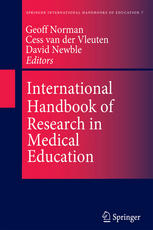

Most ebook files are in PDF format, so you can easily read them using various software such as Foxit Reader or directly on the Google Chrome browser.
Some ebook files are released by publishers in other formats such as .awz, .mobi, .epub, .fb2, etc. You may need to install specific software to read these formats on mobile/PC, such as Calibre.
Please read the tutorial at this link: https://ebookbell.com/faq
We offer FREE conversion to the popular formats you request; however, this may take some time. Therefore, right after payment, please email us, and we will try to provide the service as quickly as possible.
For some exceptional file formats or broken links (if any), please refrain from opening any disputes. Instead, email us first, and we will try to assist within a maximum of 6 hours.
EbookBell Team

5.0
18 reviewsGEOFF NORMAN McMaster University, Hamilton, Canada CEES VAN DER VLEUTEN University of Maastricht, Netherlands DA VID NEWBLE University of Sheffield, England The International Handbook of Research in Medical Education is a review of current research findings and contemporary issues in health sciences education. The orientation is toward research evidence as a basis for informing policy and practice in education. Although most of the research findings have accrued from the study of medical education, the handbook will be useful to teachers and researchers in all health professions and others concerned with professional education. The handbook comprises 33 chapters organized into six sections: Research Traditions, Learning, The Educational Continuum, Instructional Strategies, Assessment, and Implementing the Curriculum. The research orientation of the handbook will make the book an invaluable resource to researchers and scholars, and should help practitioners to identify research to place their educational decisions on a sound empirical footing. THE FIELD OF RESEARCH IN MEDICAL EDUCAnON The discipline of medical education began in North America more than thirty years ago with the founding of the first office in medical education at Buffalo, New York, by George Miller in the early 1960s. Soon after, large offices were established in medical schools in Chicago (University of Illinois), Los Angeles (University of Southern California) and Lansing (Michigan State University). All these first generation offices mounted master's level programs in medical education, and many of their graduates went on to found offices at other schools.